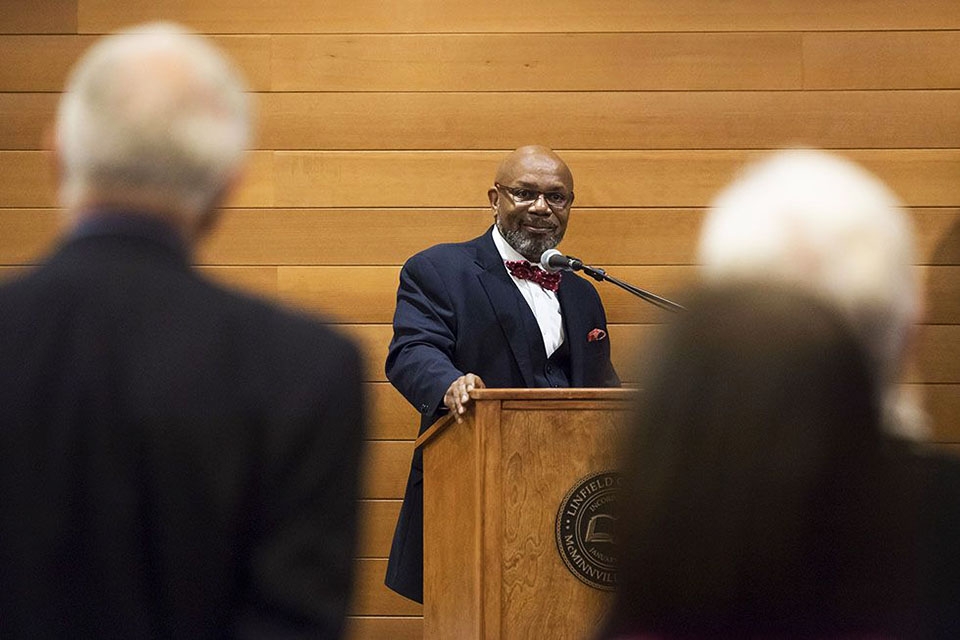
Open and honest conversation: Teaching Race in Predominantly White Classrooms
In a predominantly white classroom, psychology and race should be “taught with a level of sensitivity,” counselor Quanesha Johnson said.
“Psychology was not created with Black people in mind,” she said. “To understand the audience, the educator needs to do the work. They need to understand the impact of their words and be culturally sensitive to their audience.”
“When you’re teaching to a white viewpoint, a lot of that is not valid for all audiences. It’s coming forth with a cross-cultural understanding of psychology and an understanding of where the field came from.”
For Shank to return to Duquesne, he will be placed on a “performative improvement plan with a specific emphasis on teaching methodology,” and will work with Duquesne’s Center for Teaching Excellence (CTE) to “restructure, rewrite and organize his lessons in all courses.” Erin Rentschler, associate director of Faculty Development at CTE, said that while CTE does not talk about individual faculty or courses, the center does provide inclusive teaching practices widely recommended to the campus community.
For white professors at predominantly white institutions, the first step to teach topics like race effectively is to do “some deliberate self-reflection,” and question what they know about the intersections of race and their discipline.
“Teaching about race and racism needs to be done with intention and purpose, and it needs to recognize the realities and the significant impacts of racism in our society,” Rentschler said.
While talking about race and racism can be uncomfortable, that doesn’t mean it can be ignored, Rentschler said. When discussing these topics, teachers and professors should create spaces that are both “safe” and “brave.”
“Setting ground rules for respectful conversation and having a protocol for resisting microaggressions can set a foundation for productive dialogue,” she said.
Rentschler said that there are a “wide array of inclusive practices” that CTE recommends, from “creating ground rules for conversations; to diversifying syllabi and course materials so that students see themselves represented; to establishing a sense of belonging; to designing transparent assignments.”
Rentschler said that CTE is a “support resource” for faculty and graduate students who teach, but no one is “required” to use their services or follow their suggestions.
“Addressing issues of social justice is a cornerstone of a Duquesne education, which asks students to walk with those on the margins,” she said. “To me, that means we look within ourselves and within our campus community to see how to do better by those who are marginalized, underserved, or under resourced on our own campus and beyond.”
Patterson said that common challenges white professors face when teaching race and social justice issues is the fear of doing it wrong.
“The things I hear most often are that ‘I’m scared to do this’ or, ‘I don’t want to do it wrong,’” Patterson said. “People are afraid of being the next professors being called racist – that’s definitely a fear. Another challenge people have is the fear that they’ll never know enough to do it well. They’ll say, ‘I can read all this literature, and do all the workshops, but I’ll never understand what it’s like to be a person of color.’ While I think that’s true, I think that people can channel the empathy we have naturally for others and lean into that. Saying, ‘I can’t do it’ is an overly convenient response.”
That “conflict avoidance approach” of white professors being afraid to offend students – or fellow white peers – if they center race and social justice in the classroom, Prier said, is counterproductive.
“Such an approach negates the sum total of lived experience communities of color struggle through on an everyday basis,” Prier said. “This colorblind approach privileges ‘state standards’ without political consideration of what should be the standard for antiracist pedagogy.”
“In addition, have we considered the violence of silence to students of color when they feel their identities, voices, cultures and contexts are not integrated into content or instructional practice?”
According to Prier, white faculty can “fill in the gap between theory and practice” by inviting the local community to assist with hosting topics, conversations or lessons on race and social justice.
“The first steps for white professors to curb systemic racism in higher education, Rentschler said, involve “open and honest conversation.”
“If the climate isn’t welcoming, and people don’t feel as if they belong, policy changes alone aren’t very effective,” she said. “As in any community, we need to hold each other accountable if we expect to see larger systemic change, and we need to continue holding each other accountable once change occurs.”
If these challenges are to be overcome, Prier said that professors must center equity and social justice within the entire structure of pre-service teacher education. “This re-centering of equity expands rather than limits the possibilities for what schools of education might become,” he said.
A reporting (and support) system
A Bias Education and Response Team (BERT) has been formed “in light of Gormley’s focus on diversity and inclusion, and in response to global and campus issues,” said Jessica Mann, co-chair of BERT.
The group was formed to come together to think about a proactive and reactive approach to incidents of bias, and to acknowledge that bias exists and create a common understanding as to what it is. Previously, Mann said that incidents could be reported – students had a standard conduct channel through the Office of Student Conduct, and faculty could go through The Administrative Policies (TAPs) – but BERT will offer an opportunity to centralize a “filter” to report incidents.
“BERT is not a disciplinary body; it will just refer incidents to the appropriate channels,” she said. “It will promote educational responses of bias to the campus community.”
Reporters can self-identify themselves in reports, or they can submit anonymously. Mann said that reporters who self-identify will be contacted within 48 hours and will inquire about the reporter’s welfare, give advice, ask what support is needed and discuss options to follow-up on the report. At this point, the online reporting system for BERT is still being developed.
“Every submission will be addressed, but will be addressed case by case,” she said.
Mann said that an example of implicit bias is when a faculty member unconsciously labels someone by easily identifiable instances: and that they run on assumptions, rather than truth.
“Educators typically ask people from underrepresented groups to speak on behalf of those underrepresented groups,” Mann said. “We need to create places for faculty to think about how they think about others.”
Penn State education professor Ashley Patterson said that implicit bias is the subconscious thought of thinking about people is “normal.”
“It’s not reasonable to get rid of [implicit bias], but what we can do is be aware of them and interrupt habitual ways of thinking,” she said. “Start by making the familiar strange. Question, ‘why do I think that?’ That’s where you start to dismantle implicit bias.”
Mann said that there is a lot of research on bias and its effects, and that if someone feels stereotyped, disrespected, unwelcome or unsafe, then they are going to underperform in the classroom.
“If someone is in the classroom, and they’re feeling judged, then they are going to underperform,” Mann said. “They aren’t getting the experience that their white colleagues and peers are having.”
Counselor Quanesha Johnson said that “everything is systemic,” and that racially charged incidents impact how students of color feel in school.
“If universities want good students, they have to support them,” she said.
Learning from a “mistake”
Originally, sophomore Kaytlin Black thought Shank’s conduct was just a mistake.
“In class I was uncomfortable, but I realized he was human,” she said. “As time went on, I realized he went out of his way to say it. He could have and should have omitted it. It didn’t help our learning; it did not promote whatever we were learning.”
She said that teachers advocate for marginalized voices. She wanted to be a teacher to advocate for students whose voices aren’t always heard, and that Duquesne presented her with “various opportunities” to become the equitable teacher that she strives to be.
“Duquesne should elongate the social justice course,” Black said. “It would create more equitable teachers.”
As a white woman and future teacher, Black said that white privilege needs to be addressed.
“I had the chance to reflect and change my opinion,” Black said. “I really wanted Shank to be a good guy. But with what I was reading, it doesn’t seem like it. He knew it was wrong.”
The Shank decision, to Duquesne alumni Madison Ware, “sets a horrible precedent.” “It’s OK to make a mistake, but [Shank’s] mistake was saying a racial slur that lots of people know not to say,” Ware said.
Ware, who graduated in May 2020, said that being a Black woman at Duquesne can be difficult. As a business major, she was often the only Black student in her classes.
“When race came up in class, I was the ‘advocate,’” she said. “I always sat in the front to prove a point…for people to take me seriously and to gain respect.”
Having students take a required course on diversity – not just race – could be a step in the right direction, Ware said. The University of Pittsburgh implemented a course in August titled “Anti-Black Racism: History, Ideology, and Resistance.” The one-credit course is an online, asynchronous pass/fail course that is free.
“People don’t want to talk about race because they don’t think they can do anything. There’s an attitude of, ‘it’s not about me, so I don’t care.’ If you want to see change, you have to be uncomfortable,” Ware said. For learning to occur, Ware believes that there needs to be an understanding that everyone comes from different backgrounds, and that to have these conversations, “it’s not a bad thing to be uncomfortable.”
“You should see color – when people say, ‘I don’t see color,’ that’s a very dangerous set of words,” Ware said.
Renee Fullum, a 1977 Duquesne graduate, said that it wasn’t about the word being OK when he was growing up, but maybe where he was growing up.
But Fullum, the first Black RA in St. Ann’s Hall, said that she believes Shank does deserve a second chance – if he completes all the criteria, and passes with flying colors, Duquesne should let him come back.
“If anything, hopefully it gives courage to other students to step up when something’s wrong,” Fullum said.
***
Kellen Stepler is the editor-in-chief for The Duquesne Duke. All images were by Griffin Sendek, multimedia editor for The Duquesne Duke.



